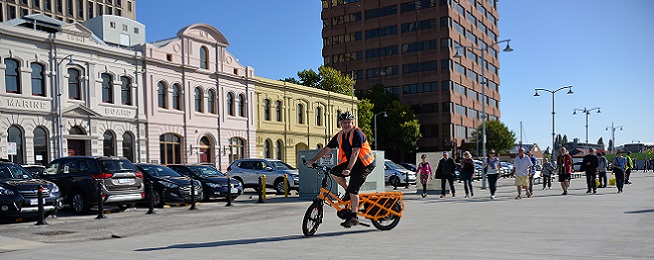As we get ready to Park it for the Planet on 26 August, the City of Hobart has released a draft five-year sustainability action plan for public comment with a few actions listed that will improve conditions for e-bike riders.
The Draft Sustainable Hobart Action Plan 2020–25 outlines 48 actions over the next five years broken into the themes: mobility, energy, waste, resilience, leadership, and governance.
The sustainability plan states it has taken its direction from the 2018 community vision that called for the council to act on climate change, reduce transport emissions, encourage the movement of people ahead of cars, provide transport options for people of all abilities and build the infrastructure needed to make riding and walking convenient and effective.
However, bicycle riding and walking only score a few actions, with the responsibility for what is really needed to change travel behaviour – a network of separated cycleways – left to the Transport Strategy, which is still in draft form.
While the sustainability plan has only been released this week for public comment, it has already drawn criticism from one councillor for being too “pie in the sky”, especially during a time of budget constraint due to COVID-19.
While there are some big-ticket items that would cost money to establish in the plan, there are plenty of initiatives that council could pursue that are low or no cost and most of the bicycle actions fall into this category.
Measures listed in the plan which aim to encourage more bicycle use include:
- Mobi-01: Diversifying and Electrifying the City’s Fleet
This could include regular and electric bicycles within the City’s vehicle pool, rather than just cars. This is an important leadership action but also has the potential to cut fleet costs. - Mobi-07: Charge your E-bike
The City would develop charging points for e-bikes and e-scooters or work with private developers to deliver them. - Mobi-08: New Micro-mobility Options
The City will work with the state government and commercial operators to trial shared e-bike and e-scooter schemes. These have been trialled in most other capitals cities and have the potential to diversity how tourists see Hobart as well as giving locals the opportunity to try an e-bike and change their perceptions of bike riding. - Mobi-09: Other City Projects
Actions already listed in the Transport Strategy (draft) 2019–30 and the Capital City Strategic Plan. These actions are where substantive change in bicycle uptake will occur.
Other low-cost measures which the City could consider to increase bicycle usage and cut emissions include:
- Changing planning laws to get rid minimum car parking requirements in new developments and instituting minimum secure bicycle parking requirements.
- Changing planning laws to require end-of-trip facilities in new commercial developments.
- Rolling out low-cost, temporary cycleway networks, such as Sydney is doing now, to give people the option of riding and help to work out which routes will be most used for a permanent network.
- Providing a one-stop shop bike hub on the city’s website so people can plan routes, find a bike park, find a bike shop and access other relevant advice and information.
- Working with the freight industry to establish hubs on the edges of the city centre so the “last mile” delivery of smaller loads can be done by cargo bicycle.
- Providing salary sacrificing options for staff to help them buy e-bikes.
There are a few ways you can find out more or offer your comments on the plan:
- Read the full plan or summary and watch the videos on Hobart’s climate action to date
- Fill out the online survey before 25 September
- Attend an online information session on 26 August, 6–7 pm, or in person at Mather’s House in Bathurst Street on 23 August, 9–11 am.


